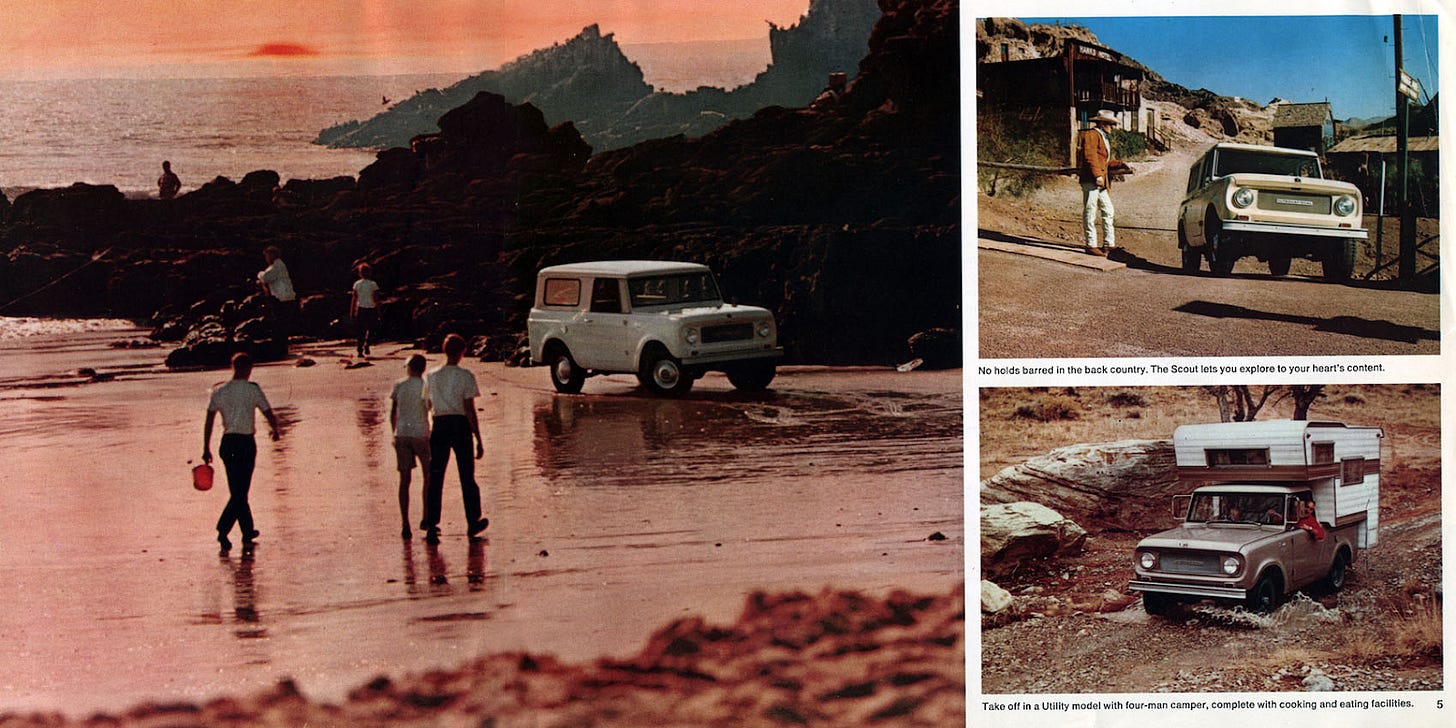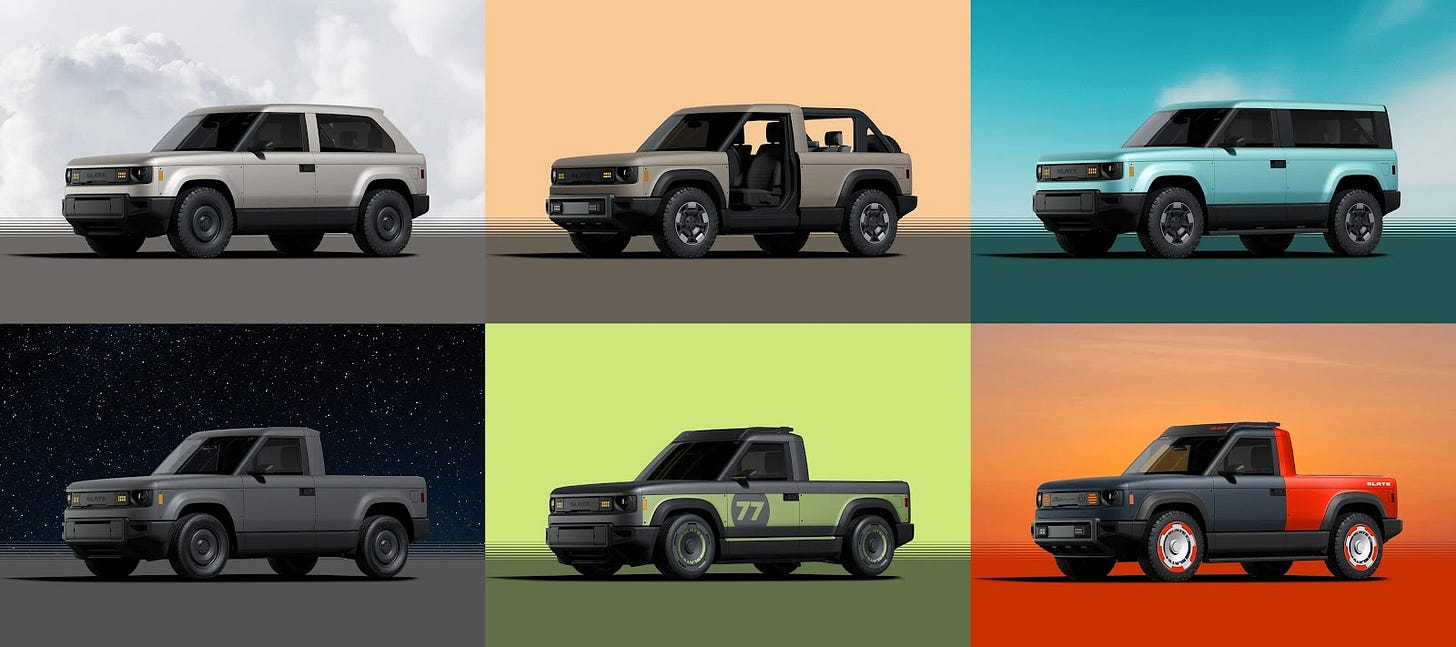Who's the real "new Scout"?: Shoddy Goods 051
Two car startups compete for one legacy
I'm Jason Toon and I'm not a car guy. But for anyone interested in the history of consumer culture - and since you're reading Shoddy Goods, the newsletter from Meh, I'll assume that includes you - you can't get around cars as the symbolic icons of peak consumerism. Just what each individual car symbolizes, though, is up for debate.
It was 1960. American cars were at their biggest, in terms of both sales and physical size. Detroit built its empire on long, low, luxurious sedans that rolled smoothly along the nation's velvety new suburban roads. Swooping tailfins. Chrome by the yard. Ever-more-improbably curved windshields. And the future just promised more of the same.
But into the midst of this streamlined intergalactic carnival rode a workhorse. Or at least a car whose design imperative was "replace the horse". You could tell by its name that the Scout was everything the Chrysler Imperial or Buick Invicta wasn't: stubby, tough, barebones, cheap, simple. Its maker, International Harvester, wasn't even a car company, and heresy of heresies, wasn't even based in Detroit.
During its 20-year run, the Scout would never vault International Harvester into the top rank of American automaking. But it would be remembered affectionately enough that now there are two electric vehicle startups competing to be its successor, in very different ways.
When you really want to feel the wind in your teeth
Scout's honor
Their stated aim may have been to "replace the horse", but International Harvester's strategic goal was to replace the Jeep. The Scout 80 was launched in 1961 as an equally rugged but more stylish and versatile alternative.
The big innovation of the original model was its modular accessories. Within minutes, with no particular expertise, the owner could change it from a compact pickup with a five-foot cargo bed, to a family roadster with back bench seats, to an adventure-ready action vehicle, to a kind of delivery truck/station wagon that looks remarkably like an SUV from a few decades into the future.
Four, four, four cars in one!
Even more appealing was the price: $1,598 base for the 2-wheel drive model (about $17k today) and $1,948 for the 4-wheel drive (about $21k today). The average car in 1961 cost something like $2,700 (about $29k today). Within a month of launching the Scout, International Harvester had to double production to meet demand.
The company had initially expected most purchasers to be businesses, but individuals bought most of the 25,000 units sold that first year. So they pivoted their strategy in subsequent model years. The Scout lost its fold-down windshield and removable doors, but gained more upholstered interiors, bucket seats, camper and vinyl sport-top options, a V8 engine, automatic transmission, and a wide variety of styling choices, including a "Red Carpet" edition to celebrate the 100,000th Scout sold in 1964.
By the '70s, rather than the hybrid work/family vehicle they'd initially envisioned, the Scout was marketed as the ultimate recreational vehicle, equally surefooted chilling on the beach or rumbling through dusty arroyos. Some great TV commercials urged the Scout-curious to "Scout the America others pass by" and gloated about its ability to drive around all the other schmucks stuck in the snow.
The official truck of finding yourself, man
A proliferation of variants ranged from the Champagne Series, with such luxuries as door panels and carpet, to the barebones Rancher Special, which came without a passenger seat, bumper, or top on the base model.
Of course, by then, it wasn't alone. With lookalike proto-SUVs like the Ford Bronco and Chevy Blazer, the Big Three took what drivers liked about the Scout, updated the engineering, and backed them with their sales muscle. Unrelated problems with International Harvester's core agricultural business left the company unable to compete at that level. The last Scout rolled off the line in 1980.
Scout of mothballs
After International Harvester went belly-up in 1986, the Scout lived on only in memories and through enthusiast groups who revered its simplicity and ruggedness in contrast to the increasingly computerized and disposable products of the automotive industry.
That remaining goodwill was enough for Volkswagen to decide to revive the Scout brand in 2022. Their subsidiary Scout Motors started construction on a $2 billion plant in South Carolina capable of building 200,000 vehicles a year. Last year, they unveiled the first new vehicles to bear the Scout badge in over 40 years, the Traveler SUV and the Terra Truck, aiming for the first sales at the end of 2027.
We've got to stop meeting like this
"The original off-road icon," their website says, leaning hard into the legacy. "The one that united work with play. The one that made 'sport utility' a household term. The one to combine a farm tool with a family hauler, and from which all others have followed since. The spirit of the original, retooled and ready for a classic American comeback."
But compact, basic, and cheap they are not. Scout Motors is aiming for the premium adventure market, with starting prices in the $50,000-$60,000 range. The Terra and Traveler are the same size as comparable models by other makers. The interiors have the touchscreens and comfort features you'd expect from any new car. The website mentions customizing with accessories, but they look like pretty routine options. When it comes to legacy, Scout Motors is all-in on the adventure but leaves the rest behind.
No, for a car that embraces the original Scout's modularity, affordability, simplicity, and stubby silhouette, you'll have to look to another startup that's also backed by some big money.
Slate to the party
"What this country needs is a good $20,000 electric truck." That seems to be the guiding principle behind Slate. Investors like Jeff Bezos and the money people behind Canva and Kayak have bet some $700 million so far on the proposition.
To get that sticker price down, Slate follows a philosophy of "radical simplicity", summed up when they say "We don't like paying for stuff we don't need." That means no onboard screens and no sound system, but mounts for your own devices. That means windows you have to roll down by hand. They drew the line at heating and A/C, though: both are standard.
There is no black or white, only shades of Slate
Also in keeping with the original Scout, they present the Slate Truck (that's its name) less as a model than as a "radical truck platform" for the user to customize. That means not only picking out options before you buy (their Slatemaker is fun to play with in a Sims-like way), but adding accessories to "Attach Points" later yourself. And yes, taking the roof on and off, to go from truck to SUV and back.
Special tip o' the hat to Slate's launch campaign, in which the vehicles are used by fake businesses such as a human taxidermy company. That's something we could've thought up back in the old Woot days. Bravo.
Anyway, some of those economizing sacrifices come in the form of performance. Its rear-wheel-drive motor has one-tenth the towing capacity of the Scout Terra. Its battery range is lower, too: from 140-250 miles, half or less than Scout Motors' vehicles. That's partly why the Slate Truck can fully recharge in 4-8 hours from a standard 240v outlet, because the charge isn't that big.
But for everyday driving and occasional light hauling, it's hard to beat that cost of ownership. If, that is, everything Slate says now turns out to be true. They're currently retrofitting a former print shop in Indiana to build the Truck, shooting for late 2026 delivery.
Scout Trek: The Next Gentrification
From Levi's, Doc Martens, and Pendleton shirts to army surplus, warehouse lofts, and stock tank pools, one generation's affordable utilitarian gear is the next generation's lifestyle brand. The new Scout seems to be another case of that. Camping itself used to be a cheaper alternative to more upscale, organized forms of recreation, hard as it is to believe if you've recently had to outfit a family for a weekend in the woods. Might as well get there in a premium car, too, if you can afford it.
This message not approved by the Flood Safety Council
But the need for cheap stuff that just works never goes away. The early response to Slate has shown that there's a market for cars that eliminate the complexities and fripperies and pass the savings on to you.
The divide is already visible in the Scout enthusiast community. "I see a lot more similarities between the Slate range of vehicles and the OG Scout 80 than anything offered by (Scout Motors)," one Redditor posted recently.
"IMO they’ve gone below what I’d consider the bare minimum required in a car," responded another. "Power windows and infotainment aren’t optional these days."
We'll have to wait another year at least to see if Scout Motors and Slate can keep their promises, and how the public reacts. Volkswagen's got the official Scout brand. But I have a feeling that if there's still a car industry 60 years from now, startups will be competing to see who can be the new Slate.
I’m often thinking about what the perfect second-car is. Assuming you’ve got one car you can take on roadtrips and load up with people and/or gear, it doesn’t really make sense to have a second card that serves exactly the same purpose, right? So, ignoring what’s actually available, let’s hear what your perfect second car would be in this week’s Shoddy Goods chat.
—Dave (and the rest of Meh)
These past Shoddy Goods stories are cheap, compact, and require very little gasoline:







